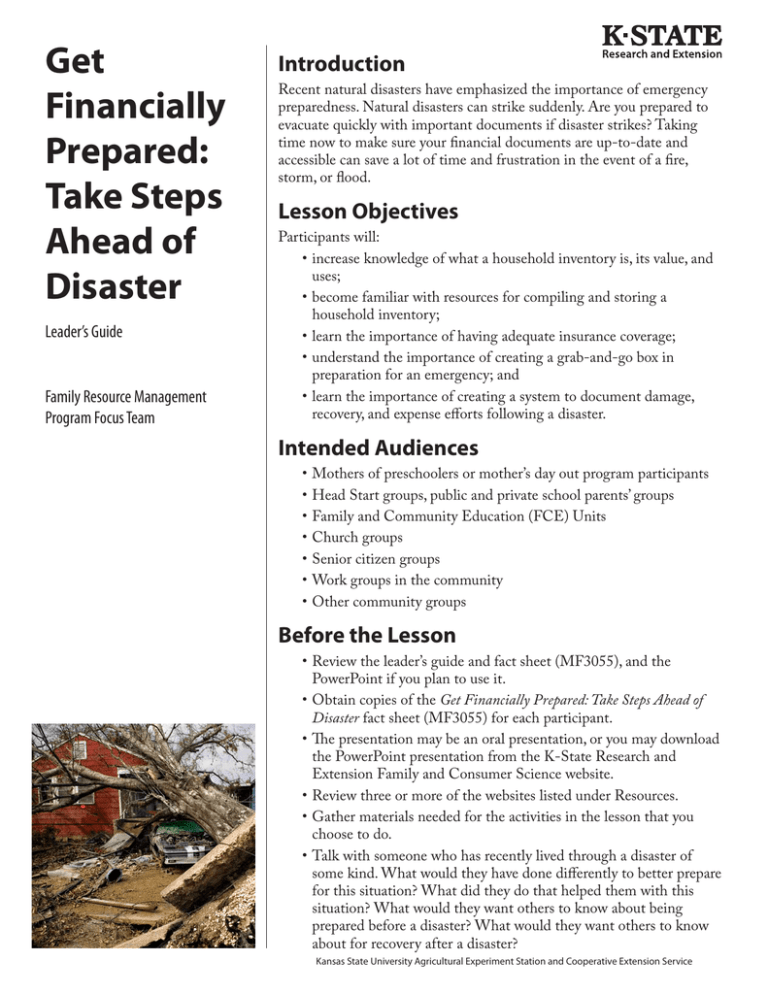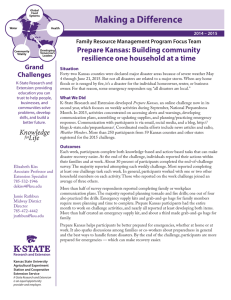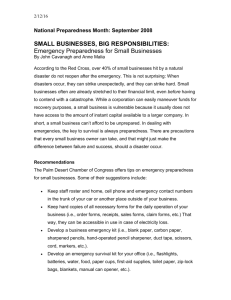
Get
Financially
Prepared:
Take Steps
Ahead of
Disaster
Leader’s Guide
Family Resource Management
Program Focus Team
Introduction
Recent natural disasters have emphasized the importance of emergency
preparedness. Natural disasters can strike suddenly. Are you prepared to
evacuate quickly with important documents if disaster strikes? Taking
time now to make sure your financial documents are up-to-date and
accessible can save a lot of time and frustration in the event of a fire,
storm, or flood.
Lesson Objectives
Participants will:
•increase knowledge of what a household inventory is, its value, and
uses;
•become familiar with resources for compiling and storing a
household inventory;
•learn the importance of having adequate insurance coverage;
•understand the importance of creating a grab-and-go box in
preparation for an emergency; and
•learn the importance of creating a system to document damage,
recovery, and expense efforts following a disaster.
Intended Audiences
•Mothers of preschoolers or mother’s day out program participants
•Head Start groups, public and private school parents’ groups
•Family and Community Education (FCE) Units
•Church groups
•Senior citizen groups
•Work groups in the community
•Other community groups
Before the Lesson
•Review the leader’s guide and fact sheet (MF3055), and the
PowerPoint if you plan to use it.
•Obtain copies of the Get Financially Prepared: Take Steps Ahead of
Disaster fact sheet (MF3055) for each participant.
•The presentation may be an oral presentation, or you may download
the PowerPoint presentation from the K-State Research and
Extension Family and Consumer Science website.
•Review three or more of the websites listed under Resources.
•Gather materials needed for the activities in the lesson that you
choose to do.
•Talk with someone who has recently lived through a disaster of
some kind. What would they have done differently to better prepare
for this situation? What did they do that helped them with this
situation? What would they want others to know about being
prepared before a disaster? What would they want others to know
about for recovery after a disaster?
Kansas State University Agricultural Experiment Station and Cooperative Extension Service
References and Resources
eXtension Articles:
Household Inventory, http://www.extension.
org/pages/11274/household-inventory
SMART Financial Goal Setting, http://www.
extension.org/pages/11099/smart-financialgoal-setting
Recovery After Disaster: The Family Financial
Toolkit, http://www.extension.org/
pages/59588/recovery-after-disaster:-thefamily-financial-toolkit
Preparing Your Pets for Disasters, http://www.
extension.org/pages/60952/preparing-yourpets-for-disasters
Family Preparedness: http://eden.lsu.edu/
EDENCourses/FamilyPreparedness/Pages/
CourseMaterials.aspx
Know Your Stuff:
Home Inventory, www.knowyourstuff.org
Insurance Information Institute:
www.iii.org
Red Cross:
Disaster Recovery, www.redcross.org/
preparedness/FinRecovery/nextweeks/loss.
html#reconstructing
How Are You Doing?
A Financial Checkup, www.ksre.ksu.edu/
library/famec2/mf2721.pdf
Publication 2949-I Preparing your Evacuation “Grab and Go” Box. LSU Ag Center
www.lsuagcenter.com/nr/
rdonlyres/405b7245-4746-4480-9578f3ce54172f2b/25562/pub2949ievacuationgrabboxfinal.pdf
Presenting the Lesson
Begin with an anchoring warm-up. Use the document titled “Rate This
List for a Basic Emergency Supply Kit” for a rate and share activity. (This
list can be found on the K-State Research and Extension FCS website or
you can email Jamie Rathbun, jrathbun@ksu.edu.) Have participants look
over the list individually, making sure they only look at the list on the
front side. Would they add anything else? After a few minutes, have them
share their observations about the list with a partner in the room. After
a few more minutes, discuss with the whole class observations about the
list. Participants can now look at both sides of the paper. The second side
is a list for financial emergency preparedness and things to put in a graband-go file or box. This list is the topic for the lesson. These sheets should
be taken home by participants so they can use them when preparing their
own emergency supply kit and grab-and-go box.
Lesson Activities
Household Inventory:
1. With a computer, white board or projector screen, and Internet
connection, show the Guided Tour of Know Your Stuff — Home
Inventory, the Insurance Information Institute’s free online home
inventory software, at www.knowyourstuff.org/iii/login.html. Or
make PowerPoint slides to show screenshots of the software, if an
Internet connection isn’t available.
2. With a computer, speakers, whiteboard or projector screen, and
Internet connection, show the Taking Inventory video (1:42),
which briefly but thoroughly demonstrates the process for
preparing a home inventory using the Insurance Information
Institute’s free online home inventory software, at
www.knowyourstuff.org/iii/login.html.
3. Have participants write a few sentences about one of their most
valued material possessions. Prompts for writing include: How
was the possession acquired? Why is it so important to them?
Besides its monetary value, what does it represent to them? What
are memories of using it or the person who gave it to them? How
would they feel if it were destroyed? Can it be replaced? Allow
time to reflect on their writing. Ask the group to share what they
wrote with a partner at their table, or ask volunteers to share what
they wrote with the class. For this activity, the instructor will need
to ensure participants have a pen or pencil, paper, and writing
surface.
Grab-and-Go
1. Ask participants if they know the phone numbers of their
insurance company, their bank account numbers, or driver’s license
number off the top of their heads. Do they know the location
of their insurance policies, home inventory, and keys to the safe
deposit box? Are they all together in one place? How quickly could
they gather the items listed under the grab-and-go box header on
the fact sheet in the event the tornado sirens were blown?
2
Authors
Family Resource Management Program Focus
Team Members:
Diane Burnett, Family and Consumer Sciences
Agent, Miami County
Valeria Edwards, Family and Consumer
Sciences Agent, Johnson County
Ronda Gordon, Family and Consumer
Sciences Agent, Lyon County
Jamie Rathbun, Family and Consumer
Sciences Agent, Ellsworth County
Cindy Williams, Family and Consumer
Sciences Agent, Meadowlark District
Deb Wood, Family and Consumer Sciences
Agent, Geary County
For questions or comments regarding this
lesson contact:
Jamie Rathbun, Family and Consumer
Sciences Agent, K-State Research and
Extension – Ellsworth County
Ellsworth County Extension Office
210 N Kansas, Suite 1
Ellsworth, KS 67439
785-472-4442
jrathbun@ksu.edu
Community Awareness Activities
• Bring items to create a grab-and-go box or notebook and give to a
local organization or family in need. Include the fact sheet from this
lesson to assist them in assembling their box.
• Partner with an organization that works with older Americans or
individuals with disabilities or special needs. Consider working
with faith-based organizations to communicate the importance of
disaster preparedness to the community.
• Pet owners should take into account special care their pets may
require during a disaster. Consider working with veterinarians
or animal shelters to inform community members of the safety
precautions necessary for pet safety and security.
• September is National Preparedness Month. Consider combining a
preparedness event with an event already planned and scheduled in
your community. Activities might include organizing practice drills,
helping people in your community make an emergency plan, or
hosting a preparedness event.
• Write a letter to the editor of a local newspaper describing the
importance of being financially prepared for a disaster.
• Use social media to promote disaster preparedness.
Reviewers
Pam Muntz
Family and Consumer Sciences Agent, K-State
Research and Extension – Kiowa County
Mary Lou Peter
Kansas Delegate, Extension Disaster
Education Network
Sara Croymans, M.Ed., A.F.C.
Extension Education and Professor
University of Minnesota Extension
3
Get Financially Prepared: Take Steps Ahead of Disaster Evaluation
What benefits did you get from this program?
I am now motivated to schedule time to accomplish some financial disaster prevention tasks.
Strongly Agree Agree Neutral Disagree Strongly Disagree
I understand the importance of creating a system to document damage and recovery expenses and efforts.
Strongly Agree Agree Neutral Disagree Strongly Disagree
As a result of participating in this program, please check which of the following actions you intend to take.
Intended Actions
Make a list of well-defined goals and actions I need to take to
get financially prepared for a disaster.
Intend
to do
Have in place but
need to update
Have in place and
remain satisfied
Have no plans (or
does not apply)
Complete a household inventory (written/photo/video).
Review insurance coverage on my home and property and
make needed adjustments.
Develop a grab-and-go box.
Other action:
What is the first thing you plan to do as a result of participating in this program?
__________________________________________________________________________________________________
__________________________________________________________________________________________________
Please share other comments on the back of this sheet.
Why am I asking for your contact information? To help us improve this program, we want to know about the changed
behaviors or actions participants take after attending this program. If you are willing to provide us with follow-up
information 30 to 60 days after your participation, please provide your contact information. Your participation is
entirely voluntary and your information will not be used in any other way.
Name:___________________________________________ Email/Phone:______________________________________
Address: _______________________________________ City:_______________________________ Zip:_____________
Brand names appearing in this publication are for product identification purposes only.
No endorsement is intended, nor is criticism implied of similar products not mentioned.
Publications from Kansas State University are available at: www.ksre.ksu.edu
Publications are reviewed or revised annually by appropriate faculty to reflect current research and practice.
Date shown is that of publication or last revision. Contents of this publication may be freely reproduced for educational purposes.
All other rights reserved. In each case, credit Family Resource Management Program Focus Team, Get Financially Prepared:
Take Steps Ahead of Disaster, Leader’s Guide, Kansas State University, August 2012.
Kansas State University Agricultural Experiment Station and Cooperative Extension Service
MF3056
August 2012
K-State Research and Extension is an equal opportunity provider and employer. Issued in furtherance of Cooperative Extension Work, Acts of May 8 and June 30, 1914,
as amended. Kansas State University, County Extension Councils, Extension Districts, and United States Department of Agriculture Cooperating, John D. Floros, Director.






